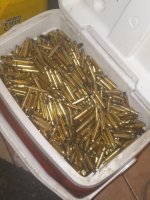So I've got a new 6 mm creedmoor gasser that I developed a load for during the brass shortage. I ended up resizing some old Hornady 6.5 creedmoor brass down to 6mm. Using 100 grain Hornady interlock, the hornady manual gives me a starting 35.6 and a max charge of 43.9 with H4350. I usually test in half grain increments so I shot 17 different loads, which had 3 different nodes. I ended up settling on 41.5 grains as it seemed to give me the best sd numbers and I was right at 3000 fps and shot a 3/4 inch group at 100 yards.
So I finally scored scored some Starline brass and want to start over load development with the new brass. I'd like to do it with saving as much components as I can. The old Hornady brass ranged from 149 grain to 155 grain per piece. The starline brass is definitely more consistent at 160 to 162 grains per piece. I haven't measured case capacity between the two but I imagine it's less with the starline because of the weight of the brass.
My question is, is it possible to get in the same node with the new brass? Really would like to stay in that 3000 fps mark as long as I get the accuracy and good SD numbers. I'm hoping to not have to go out and shoot 17 different loads for my ladder test. I know the barrel shoots good. Just trying to do load development using the least amount of components.
So I finally scored scored some Starline brass and want to start over load development with the new brass. I'd like to do it with saving as much components as I can. The old Hornady brass ranged from 149 grain to 155 grain per piece. The starline brass is definitely more consistent at 160 to 162 grains per piece. I haven't measured case capacity between the two but I imagine it's less with the starline because of the weight of the brass.
My question is, is it possible to get in the same node with the new brass? Really would like to stay in that 3000 fps mark as long as I get the accuracy and good SD numbers. I'm hoping to not have to go out and shoot 17 different loads for my ladder test. I know the barrel shoots good. Just trying to do load development using the least amount of components.



